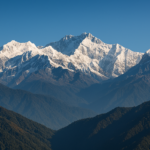
July is a month rich with historical events, natural phenomena, and cultural celebrations. From the blazing heat of Death Valley to the cool festivities of National Ice Cream Day, July offers a diverse array of facts that highlight its unique significance. Here are some intriguing trivia pieces about this vibrant summer month, shedding light on its various aspects.
Lightning Strikes: In July, the Northern Hemisphere witnesses an average of 10 lightning strikes per second, reflecting the peak of electrical storm activity. This high frequency of lightning is due to the increased atmospheric instability and moisture during summer, which are key ingredients for thunderstorm development. The National Oceanic and Atmospheric Administration (NOAA) monitors these phenomena using satellite technology and ground-based lightning detection networks, helping to predict and study storm patterns. Lightning can cause wildfires, power outages, and pose significant risks to life and property, emphasizing the importance of understanding and preparing for these natural events.
Midnight Sun in Alaska: Utqiagvik, Alaska, the northernmost city in the United States, experiences a unique natural phenomenon known as the midnight sun. From late May to late July, the sun remains continuously above the horizon for 84 days. This occurs because Utqiagvik is located above the Arctic Circle, where the axial tilt of the Earth during summer results in extended periods of daylight. The prolonged sunlight affects daily life, influencing local culture, wildlife behavior, and even human sleep patterns. Residents and visitors often use blackout curtains to manage the constant daylight.
Independence Day Fireworks: The 4th of July, American Independence Day, is celebrated with over 15,000 fireworks displays across the United States, as reported by the American Pyrotechnics Association. This tradition dates back to the first anniversary of the Declaration of Independence in 1777. Fireworks symbolize the celebration of freedom and national pride, with large cities like New York, Washington D.C., and Boston hosting some of the most spectacular displays. The preparation and execution of these events involve significant coordination and safety measures to handle the pyrotechnics and manage large crowds.
Death Valley Temperature Record: On July 10, 1913, Death Valley, California, recorded the highest air temperature in the United States at a scorching 134°F (56.7°C). This record is recognized by the National Weather Service and stands as one of the hottest temperatures ever recorded on Earth. Death Valley’s extreme heat is due to its below-sea-level basin, clear skies, and dry air, which create ideal conditions for intense solar heating. These temperatures can pose severe risks to health and safety, requiring visitors and residents to take precautions such as staying hydrated and avoiding outdoor activities during peak heat hours.
Tour de France: The Tour de France is a prestigious and grueling three-week cycling race covering approximately 2,100 miles (3,380 km) across various terrains in France. Typically starting in late June and concluding on the second Sunday of July on the Champs-Élysées in Paris, the race includes stages that test cyclists’ endurance, speed, and strategy. Riders compete for the coveted yellow jersey, awarded to the overall leader. The race attracts top international cyclists and millions of spectators, both on the course and via global broadcasts, showcasing the beauty and diversity of the French landscape.
Wimbledon Championships: The Wimbledon Championships, held over two weeks in late June and July, is the oldest and one of the most prestigious tennis tournaments in the world. Players are required to adhere to a strict dress code of predominantly white clothing, a tradition dating back to the Victorian era when white was considered to display modesty and reduce visible sweat. The tournament takes place at the All England Club in London, featuring grass courts that add a unique challenge to the gameplay. Wimbledon is renowned for its traditions, including the consumption of strawberries and cream by spectators, and attracts top tennis talent and a global audience.
World Chocolate Day: Celebrated annually on July 7th, World Chocolate Day is a global tribute to one of the most beloved confections. The day marks the introduction of chocolate to Europe in the 16th century. Chocolate’s history dates back to ancient Mesoamerican cultures, where it was consumed as a bitter beverage. Today, it is enjoyed in various forms worldwide, from bars and truffles to drinks and desserts. The celebration often includes events such as chocolate tastings, special promotions by chocolatiers, and educational activities about the production and benefits of chocolate.
Big Ben Construction: Construction of the iconic clock tower, Big Ben, in London began on July 11, 1843. Officially named the Elizabeth Tower, the structure is part of the Palace of Westminster and houses the Great Bell, known as Big Ben. The clock face, with a diameter of 23 feet (7 meters), is a remarkable feat of Victorian engineering. Completed in 1859, Big Ben has since become a symbol of British heritage and resilience. The tower and its clock mechanism undergo regular maintenance to preserve their functionality and historical significance, attracting millions of visitors annually.
Amelia Earhart’s Disappearance: Pioneering aviator Amelia Earhart mysteriously disappeared over the Pacific Ocean on July 2nd, 1937, during her attempt to circumnavigate the globe. Earhart was one of the most celebrated aviators of her time, known for her solo transatlantic flight in 1932. Her final flight, piloted in a Lockheed Electra, was intended to be the longest around-the-world journey at the equator. Despite extensive search efforts, neither Earhart nor her navigator, Fred Noonan, were found, and their fate remains one of aviation’s greatest unsolved mysteries. Various theories abound, but no definitive evidence has surfaced to explain their disappearance.
Mango Season: July marks the peak season for mangoes, known as the king of fruits. India, the world’s largest producer of mangoes, harvests over 18 million tonnes annually. Mangoes, native to South Asia, have been cultivated for thousands of years and are an integral part of Indian cuisine and culture. The fruit is celebrated in festivals and fairs across the country, showcasing a wide variety of mango species. Mangoes are not only prized for their sweet, juicy flavor but also for their nutritional benefits, being rich in vitamins A and C, fiber, and antioxidants.
National Hot Dog Day: On July 18th, Americans celebrate National Hot Dog Day, during which an estimated 7 billion hot dogs are consumed throughout the summer season. Hot dogs, a staple of American cuisine, especially at barbecues and sporting events, have origins tracing back to German immigrants who brought frankfurters to the US in the 19th century. The day is marked by hot dog eating contests, discounts at various food vendors, and festivities that highlight this popular fast food. The National Hot Dog and Sausage Council promotes the celebration, providing guidelines and fun facts about hot dogs.
Stonehenge Summer Solstice: Stonehenge, the prehistoric monument in England, aligns with the summer solstice, which usually falls on June 20th or 21st but can extend into early July. This alignment draws thousands of visitors who gather to witness the sunrise over the Heel Stone, marking the longest day of the year. Stonehenge’s construction, dating back to around 3000 BC, suggests that it may have served as an ancient astronomical observatory or a site for ritual ceremonies. The solstice event at Stonehenge continues to be a significant cultural and spiritual gathering, blending ancient traditions with modern celebrations.
MLB All-Star Game: Major League Baseball holds its All-Star Game in mid-July, featuring the best players from the American League and the National League. Known as the “Midsummer Classic,” the game is a showcase of talent and a highlight of the baseball season. Fans vote for the starting players, while managers select the remaining roster. The event includes festivities such as the Home Run Derby, which precedes the game, and various fan activities. The All-Star Game has been a tradition since 1933, providing a platform for players to display their skills and for fans to celebrate their favorite sport.
Youngest Everest Climber: At the age of 13 years and 146 days, Malala Yousafzai became the youngest person to climb Mount Everest in July 2017. Her achievement was widely celebrated, highlighting her determination and the rigorous training required to conquer the world’s highest peak, standing at 29,032 feet (8,849 meters). Climbing Everest involves significant physical and mental challenges, including extreme weather, high altitudes, and the risk of avalanches. Malala’s ascent is a testament to her perseverance and has inspired many young climbers to pursue their own mountaineering dreams.
National French Fry Day: National French Fry Day is celebrated on July 13th, honoring one of the most popular fast-food items globally. French fries, known for their crispy exterior and soft interior, are enjoyed with a variety of seasonings and dips. Originating in Belgium, where they were first fried in the late 17th century, fries have become a staple in many cuisines. On this day, restaurants and fast-food chains often offer special promotions and discounts, and some even create unique fry-based dishes. The celebration highlights the cultural significance and widespread love for this simple yet versatile food.
National Ice Cream Day: Celebrated on July 17th, National Ice Cream Day recognizes the beloved frozen dessert enjoyed by millions. The United States, where the day was proclaimed by President Ronald Reagan in 1984, sees an average consumption of 22 gallons (83 liters) of ice cream per person annually. The day is marked by various events, including ice cream socials, special promotions at ice cream parlors, and creative flavor launches. Ice cream, which has a history dating back to ancient civilizations, continues to evolve with new trends such as plant-based options and exotic flavor combinations.
Moon Landing Anniversary: On July 20th, 1969, the world watched in awe as Neil Armstrong became the first human to walk on the moon during the Apollo 11 mission. This historic event was broadcast live, with Armstrong’s famous words, “That’s one small step for man, one giant leap for mankind,” resonating globally. The mission, a major achievement in the Space Race, was conducted by NASA and involved a team of astronauts, including Buzz Aldrin, who also walked on the moon, and Michael Collins, who orbited in the command module. The moon landing demonstrated remarkable technological prowess and remains a symbol of human exploration and ingenuity.
Ancient Olympic Games: According to historical records, the ancient Olympic Games in Greece traditionally began on a full moon in July. These games, held in Olympia, were a significant part of Greek culture, dating back to 776 BC. The events included various athletic competitions such as running, wrestling, and chariot racing, and were held in honor of the god Zeus. Athletes from different city-states competed, fostering a spirit of unity and competition. The ancient Olympics were also a time for religious ceremonies and cultural exchanges, making them a cornerstone of ancient Greek society and influencing the modern Olympic Games.
Inventors’ Hall of Fame: The National Inventors’ Hall of Fame inducts new inventors into their ranks each year during a ceremony held in July in Alexandria, Virginia. This event honors individuals whose innovations have significantly impacted society and advanced technology. Inductees include pioneers in various fields such as medicine, engineering, and computer science. The Hall of Fame, established in 1973, not only recognizes these inventors’ contributions but also promotes the importance of innovation and creativity. The ceremony includes presentations, networking opportunities, and celebrations of the achievements that have shaped modern life.
FAQs about the month of July:
Q: Why is July named after Julius Caesar?
A: July is indeed named after Julius Caesar, the famous Roman general and statesman. The Roman Senate bestowed this honor upon him in 44 BC, the month of his birth. Before this, July was known as Quintilis, which simply meant “fifth month” in the Roman calendar that began in March.
Q: What is the hottest temperature ever recorded in July?
A: The hottest temperature ever recorded on Earth – not just in July – was a scorching 134°F (56.7°C) in Death Valley, California on July 10th, 1913. This scorching temperature remains the official world record according to the National Weather Service.
Q: What are some major holidays celebrated in July around the world?
A: July is a month packed with celebrations around the globe. Here are a few notable ones:
4th of July (United States): This marks American Independence Day, commemorating the adoption of the Declaration of Independence in 1776. Fireworks displays and patriotic celebrations are widespread.
Bastille Day (France): Celebrated on July 14th, this French national holiday commemorates the storming of the Bastille prison in 1789, a pivotal event in the French Revolution. Military parades and fireworks are traditional festivities.
World Chocolate Day (Global): Chocoholics rejoice! Every year on July 7th, this day is dedicated to the appreciation of all things chocolate.
Q: What are some interesting astronomical events that happen in July?
A: The sky offers some intriguing sights in July:
Summer Solstice: This astronomical event, usually occurring around June 20th or 21st but sometimes extending into early July, marks the longest day and shortest night of the year in the Northern Hemisphere.
Meteor Showers: Stargazers can look out for the Delta Aquariid meteor shower, peaking around July 28th, and the Alpha Capricornids meteor shower, reaching its peak in mid-July.
Q: Is July a good time to visit specific destinations?
A: July is a prime travel month for many places, but the ideal destinations depend on your preferences:
Beach Vacation: For warm weather and sunshine, many flock to coastal destinations in the Northern Hemisphere like the Mediterranean, California, or the Caribbean.
National Parks: Temperatures can be high in some National Parks, but July offers long daylight hours for exploration in places like Yellowstone or Yosemite.
Europe: While July can be crowded in popular European cities, it’s also a good time to experience summer festivals and outdoor activities.








